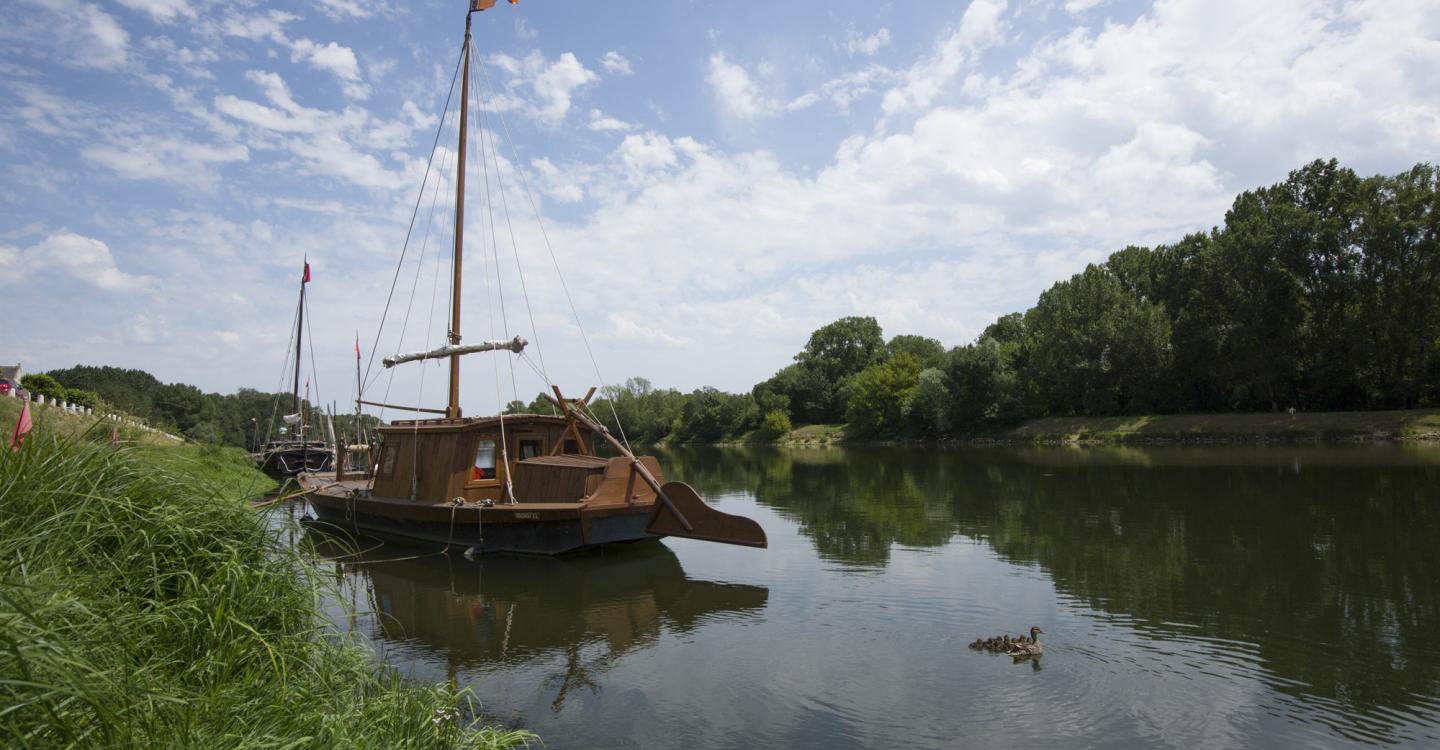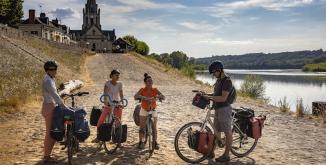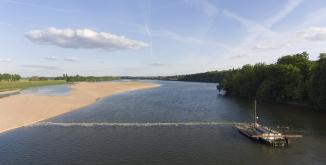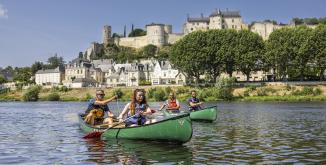1000 kilometres of waterway stretch from the Mediterranean hinterland to the Atlantic sea. The Loire and its affluents have always been a great asset for the territories they run through.
The presence of a river enhances the development of trade, especially in the 18th century. Local resources (wine, tufa, fruits, …) are shipped much further than the Anjou or Touraine boundaries. Bargees bring back goods from other regions.
Navigating on the Loire is not always easy. The water level can change a lot and sometimes very fast. In order to adapt to these changing conditions, shipwrights imagine special boats which shall become typical for the region: barges, scows, wherries, … They are all built both to resist extreme weather situations such as storms and to allow navigation at low water level.
The bargees on their hand develop different techniques for making navigation easier. E.g. the train of barges allowed to control the descent and going up the river by attaching boats together both lengthwise or widthwise.
Going downstream, boatmen use the current strength to reach the ocean. Whereas sailing upstream, they use the west winds coming in from the Atlantic sea to push them countercurrent.
During the Golden Age of the Loire navy, there were a whole lot of sailors and fishermen. In addition to these professions, the Loire also created indirect employment: ropemakers worked on hemp from Bréhémont and basket makers used wicker from Chouzé…
For a long time, the cheapest way of transporting goods was shipping them on the Loire river. With the rise of steam boats after the Industrial Revolution, even passenger transport became possible on the river. The decline of the Loire navy started with the spread of railway and road transport in the 19th century.
Today, the river is still a central part of the territory, offering a beautiful frameset for tourism and leisure activities as well as celebrations. Some traditional boats are back into business. Tourism professionals organise circuits or overnight stays in a so-called “toue cabanée”, a small traditional flat-bottomed fisher boat.
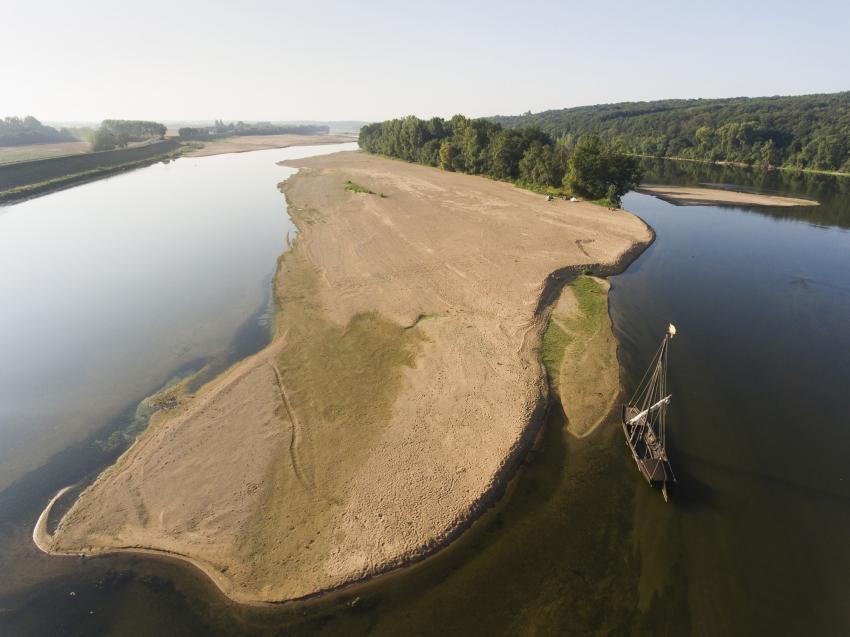
Boats of the Loire
The Loire is a moody river: its water lever can rise in no time or fall dramatically, depending on seasons and weather conditions. In order to allow navigation no matter the conditions, shipwrights had to come up with ingenious plans. Flat-bottomed boats, e.g., were developed for the low-water level periods. All boats are very solidly built to resist storms and gusts of winds. They are also often higher up front and have a mast with one big square sail. The rudder (also called the “piautre”) can be adapted to the water level thanks to its oblique axis and its adjustable dip. On board, bargees used wind vanes to observe the wind’s direction. The most common boats of the Loire are:
- the barge or the scow, the biggest ships of the Loire navy (24-30 metres);
- the “toue” which was used for fishing or transporting people;
- the wherry, a small boat similar to the tender at sea;
- the “sapine”, a simple boat for single usage without mast nor sail which uses the current to descent the Loire and is dismantled after usage;
- le “fûtreau”, the smallest boat type of the Loire used for shipping passengers across the river; In Saumur, Montsoreau, Bréhémont or La Chapelle-sur-Loire tourism activities are organised on some of the boats described above.
Navigation on the Loire
Man has developed different techniques to adapt shipping to the changing navigation conditions. The train of barges is one of them: when going upstream, the boats are attached one to another like the wagons of a train. When going downstream, boats navigate two by two “en couplage”): they are attached together lengthwise. The leading boat is called “boutavant”, followed by the “tirot”; and the “sous-tirots” if they are more than two. The boat with the biggest sail takes the lead, the others follow with decreasing sail sizes. This technique starts to decline in the 19th century when priority is given to separate shipping in order to charge faster, with better security and arrive to destination faster as well.
When crossing under a bridge, bargees use a technique called “endrémage de volée” to gain some time: the leading ship lowers its mast and is pushed by the others. Once it has crossed the bridge, it lifts the mast and sail again and tears the other boats.
The “endrémage” technique can only be used with wind. In case of slump, bargees used the technique of towing. The boat is town from the riverbank with a long rope attached to the masts. It needs up to 50 men to tow a train of barges going upstream. This can also be done by an animal or, at later times, mechanically with tractors on tires or rails. It is an expensive technique, so most of the time, the sailors prefer waiting for the wind to return.
Shipping goods and passengers
Meandering over 1000 kilometres from the Ardèche mountains to Saint-Nazaire, the Loire allows to access the Mediterranean hinterland as well as the Atlantic sea. It opens many different markets to local productions.
The long-standing practice of river trade reaches its apogee around 1860. Routes are dangerous then, in bad shape and unsecure: inland shipping is the surest way to transport goods.
Merchants take care of trading and transport. To forward the goods, they sign contracts with bargees who are responsible of the cargo from the moment it is charged from the harbour.
Boats mainly transport salt, sugar, wheat, wood, tufa and wine. Some local products are very successful: prestigious wines of the Loire are served at Parisian tables; prunes from Tours are known far beyond French borders; tufa stones are used to build the cathedral of Nantes and the Parliament of Brittany in Rennes … Some cargos get really far: sometimes all the way to the Caribbean islands.
In the early 19th century, passenger transport develops. The invention of steam boats makes navigation faster, more comfortable and secure: passengers appreciate travelling on the river, enjoying the speed and range of the new boats.
Life of a bargee
Bargees spend most of their time navigating and can be absent from their homes for many months. They sometimes learned about the birth of their child from another bargee met during a stopover in a harbour!
It used to be a family profession, taught by a father to his son: the know-how is passed on from one generation to another. Young men start as assistant bargees on the bottom of hierarchy in order to learn the tricks of the trade while taking care of the chores. At the next level, the bargee trainees are put in charge of the cargo.
Marriage is arranged between bargees’ families of the same region. Some farmers’ or wine growers’ children have also joined the Loire navy which was a major job provider.
On land, you can easily recognise them by their short blouses. They like gathering in cabarets to relax, play cards or sign contracts. They have a reputation of wild and unpredictable men, just like the Loire river. And yet, they are open-minded and don’t hesitate to help people around them, e.g. during spectacular floods when their great knowledge of the river helps to save peasant who take shelter on their roofs….
Bargees are not protected from accidents: under the pressure of an urgent delivery, they sometimes take miscalculated risks. Those who fall in the water drown because they can’t swim. And during strong winds, falling goods can injure or kill a crew member.

